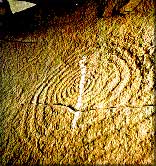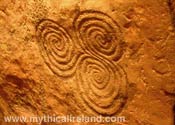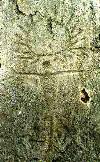Solar Rock Art
Rock Art and other Ancient Solar Imagery
We think that the Sun watcher is not a good man. He was wrong last
year. The Hopi think that is why we had so much cold this winter and
no snow." --Crow Wing 1925
Ancient cultures certainly observed the celestial bodies.
But because so few of them left any written records, it
is difficult to imagine how they interpreted the skies.
A few examples remain of imagery, usually left in rock
which may refer to the Sun. What do you think
these ancient images mean, and why do you think they were
created?
 |
Almost 500 feet above rocky Chaco Canyon, in what is now New Mexico, stands
a huge rock structure, Fajada Butte.
Atop the butte, in a wedge amongst the rocks, are several spiral figures
carefully pecked into the rock. At noon on the Summer Solstice, a dagger
of light pierces the spiral. This butte was a sacred space for
the Chacoans who built their spiritual center in the canyon.
Fajada Butte and Chaco contain many rock carvings and alignments
related to the Sun's and the Moon's cyclical patterns.
See
Traditions of the Sun, an experiential web site that lets you
explore Chaco Canyon, learning about NASA research on the Sun and Native American solar
practices within a larger historical and cultural context.
For more information on Chaco, see
Chaco Canyon.
|
|

Click for larger version
|
Chaco Canyon Man and Sun petrograph, created by Anasazi (ancient
Native Americans) somewhere between 900 and 1130 AD.
|
|

|
Triple spiral symbol on
Newgrange, an
ancient mound in Ireland.
Built some 5,300 years ago, this sacred place is one of the oldest built
structures in the world, and certainly the oldest with astronomical
alignments.
Known in Gaelic as Uaimh na Griine, 'the cave of the sun',
Newgrange's origin purpose is unknown.
|
|
 |
Copper Age image of man and sun from Ossimo boulder n. 8,
Valcamonica
(in the Alps).
See also
Sun images in the Rock Art of Valcamonica and Valtellina
|
|---|
Image Credits:
| |

